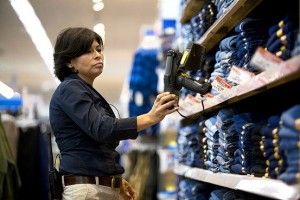Wasp Barcode Technologies: The Barcode Solution People
Wal-Mart Uses RFID to Track Underwear
Wal-Mart Stores Inc. has been using
RFID (radio frequency identification) tags to track pallets of products throughout their supply chain. The RFID tags have unique identification codes encoded in them, just like a barcode, but they can be read at a distance even outside of the line of sight. Now they plan expand that system to track individual products. They are beginning with putting removable RFID tags on pairs of jeans and underwear. If the test is successful, they will implement the tracking system to all of their products.

The goal is to increase inventory awareness and accuracy in the stores as well as ensure that the shelves are optimally stocked, which could lead to more sales. According to Avery Dennison Corp., a maker of RFID equipment, a similar pilot program at American Apparel Inc. in 2007 found that stores using RFID tags saw sales rise 14.3% compared to stores without the technology. J.C. Penney and Bloomingdale's have also been using RFID tags on clothing to better ensure shelves remain stocked with sizes and colors customers want. Another benefit Wal-Mart expects is the reduction of theft because it will be easier and faster to see if something's gone missing.
Just as with their RFID pallet-tracking initiative, Wal-Mart is requiring that the clothing companies supply the RFID tags for their merchandise. Those companies will also have to invest in RFID hardware and software to generate, encode, and verify the RFID tags. The RFID software will need to keep logs of which tags were shipped to which Wal-Mart store or distribution center in case there are any problems later on, such as a recall. The upside for manufacturers is that RFID label prices have dropped from 50 cents apiece to about 7-10 cents in the last few years and Wal-Mart is subsidizing some of the costs for its suppliers. They can also focus on the potential boost in sales that this system could bring if implemented and maintained properly.

Privacy is a concern that gets brought up immediately whenever RFID is mentioned. Privacy advocates are worried that unscrupulous marketers or criminals could scan people’s trash to determine what items they’ve just bought. We have to wonder what marketing company would have the time to stop at each house in their target area to scan the trash bags and record what that individual household has purchased just so they can mail out ads or start a call campaign. Marketers have a tough enough job proving an ROI on marketing campaigns and that sounds like a big investment in man hours. Speaking of investment, a criminal would need to spend about $3000 to get a mobile RFID reader to be able to scan trash bags. They’d have to steal a whole lot of jeans and underwear to make a profit! Seriously, though, that could be a valid concern later on if all products have RFID tags, including laptops, smartphones, and Blu-ray disc players. RFID tags can’t be turned off, but they aren’t indestructible. Once the antenna is cut or torn, it can’t send out its signal anymore.
Another factor that we never hear discussed in articles on the pros and cons of RFID is the physics of the technology. Most people tend to think of handheld RFID readers like magic wands that they can just wave around a room and instantly know what all is there. In fact, Raul Vazquez, the executive in charge of Wal-Mart stores in the western U.S., says, "This ability to wave the wand and have a sense of all the products that are on the floor or in the back room in seconds is something that we feel can really transform our business." The reality is that RFID tags use radio waves, not magic, to send out their signals that are picked up by the readers. Radio waves don’t travel well through metal or liquids. In fact, none of the RFID tags that we’ve seen will work if they are placed directly on a metal surface. There has to be a buffer layer of some kind. We’ve heard rumors of a new RFID tag that is not affected by metal, but we haven’t seen it in action yet. It still doesn’t address the problem with liquids. Beverages, cleaning chemicals, paint, etc: in all of their aisles in Wal-Mart, the RFID signal will be horribly muted if not deadened entirely.
Advocates for this type of system look to the future and see something reminiscent of a scene on the Starship Enterprise. "We are going to see contactless checkouts with mobile phones or kiosks, and we will see new ways to interact, such as being able to find out whether other sizes and colors are available while trying something on in a dressing room," said Bill Hardgrave, head of the RFID Research Center at the University of Arkansas, which is funded in part by Wal-Mart. "That is where the magic is going to happen. But that's all years away." There’s that word again: “magic”. Don’t get us wrong; we’re not completely skeptical. The shopping experience has changed quite a bit in the last 15 years first with pin pads, then pay-at-the-pump, and now contactless payments and mobile coupons on cell phones. But Mr. Hardgrave is right that the end of checkout lines altogether is years and years away.




